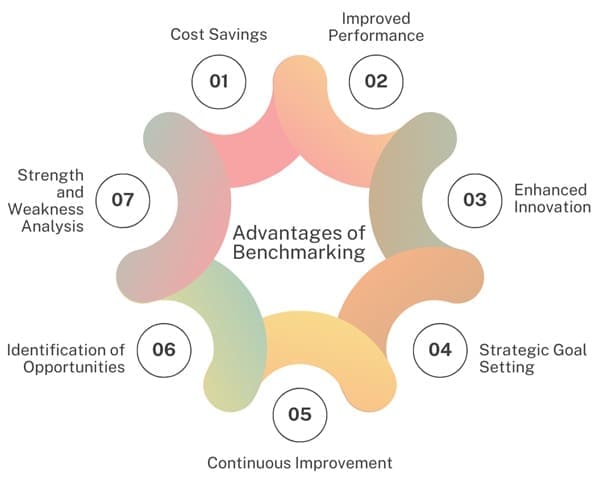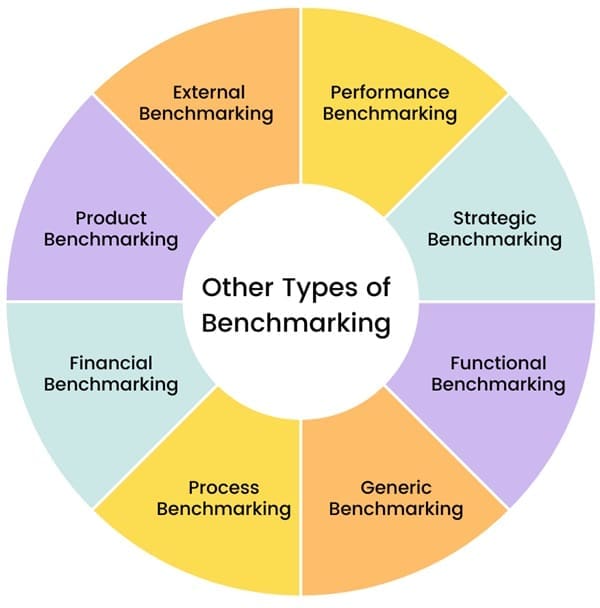Benchmarking is a strategic tool that organizations use to improve their performance by learning from the best practices of others.
It involves comparing specific aspects of a company’s processes, products, or services against industry leaders or top performers in other sectors. By doing so, companies can identify areas for improvement and adopt practices that will enhance their own efficiency, productivity, and competitiveness.
Table of contents
What is Benchmarking?
Benchmarking is about more than just comparison; it’s a structured process that enables organizations to measure their performance against others and understand what makes those organizations excel.
According to the American Productivity & Quality Center (APQC), benchmarking involves identifying, understanding, and adapting practices from companies worldwide to improve one’s own performance.
Essentially, benchmarking provides a reference point or standard, enabling companies to evaluate their current standing and strive towards excellence by aligning with the best practices.
History
Benchmarking originated in the 1950s with W. Edward Deming’s influence on quality control in Japan, where companies like Toyota refined their processes by adapting elements of Ford’s production methods. However, the formal practice and term “benchmarking” didn’t emerge until the 1980s in the United States.
Companies such as Xerox, Ford, and Motorola led the way, with Xerox’s Robert Camp being a pivotal figure. Camp defined benchmarking as the pursuit of best practices that drive superior performance, establishing it as a core part of Total Quality Management (TQM).
By 1989, benchmarking had become a recognized tool for organizational improvement, incorporated into the Malcolm Baldrige National Quality Award criteria. It involves comparing an organization’s processes and practices with those of industry leaders to identify areas for improvement. Through systematic analysis, companies like IBM, Boeing, and Johnson & Johnson applied benchmarking to boost their performance.
Why Benchmark?
Organizations engage in benchmarking to gain insights into where they stand compared to others. This process helps uncover gaps in performance and provides actionable insights for improvement. By benchmarking, organizations can avoid the time and costs associated with developing practices from scratch, as they can directly adapt what has been proven to work well elsewhere.
Moreover, itcan break industry norms, encouraging businesses to explore beyond their sector for innovative practices, which can lead to significant performance gains.
What to Benchmark?
It can focus on various areas of strategic and operational importance within an organization. This includes key processes like strategic planning, decision-making, customer service, HR practices, internal communications, and logistics.
For example, Xerox regularly purchases and disassembles copiers from competing companies to analyze their products, allowing Xerox to stay ahead in terms of innovation and functionality.
Who to Benchmark Against?
Benchmarking can be done internally, within different divisions or departments of an organization, or externally, against competitors or leaders in other industries.
Competitors are a natural choice for benchmarking since they operate under similar conditions and face the same market challenges. However, organizations also look beyond their industry to companies recognized for their world-class practices.
For instance, a healthcare provider might benchmark its service quality against the hospitality industry to improve customer experience.
Advantages

It offers several benefits, including:
- Cost Savings: Organizations can reduce costs by adopting proven practices instead of developing new ones.
- Improved Performance: By learning from the best, companies can implement advanced practices that drive superior results.
- Enhanced Innovation: Exposure to new ideas and methods encourages innovation and a proactive approach to challenges.
- Strategic Goal Setting: It provides concrete standards for setting realistic and achievable goals.
- Continuous Improvement: It fosters a culture of continuous improvement and organizational learning.
- Identification of Opportunities: By comparing performance with competitors, companies can uncover strategic market opportunities that lead to enhanced product quality and customer satisfaction.
- Strength and Weakness Analysis: It facilitates a clear understanding of operational strengths and weaknesses, enabling companies to set focused business strategies for improvement.
Three Main Types of Benchmarking
It can be categorized into three primary types: internal, competitive or industry, and best-in-class.

- Internal Benchmarking: This is often the first step in benchmarking and involves comparing processes or functions within an organization. It helps identify the best practices within different units or locations of the same company. Internal benchmarking sets a foundation for external comparisons and ensures a standardized approach when comparing processes with other organizations.
- Competitive or Industry Benchmarking: This type of benchmarking focuses on assessing performance against direct competitors or within the same industry. It helps organizations understand how their operations stack up against their peers and identifies areas that may require improvement. By evaluating competitors, organizations can gain insights into industry trends and customer expectations.
- Best-in-Class Benchmarking: Best-in-class benchmarking looks beyond the organization’s own industry and seeks out top performers regardless of their sector. The objective is to identify innovative practices that can be adapted to improve specific functions or roles. This approach fosters creative thinking and allows organizations to incorporate new strategies that may not yet be common in their field.
Other Types

There are several types of benchmarking, each with a distinct focus:
- Performance Benchmarking: This involves comparing a company’s performance with others to evaluate its standing in the industry.
- Strategic Benchmarking: This focuses on examining the long-term strategies and decisions of top organizations, enabling companies to align their strategic objectives accordingly.
- Functional Benchmarking: This type examines specific functions within the organization, comparing them to the best in similar non-competing sectors.
- Generic Benchmarking: This is a broad comparison of processes and practices against best practices across various industries, regardless of the specific sector.
- Process Benchmarking: Focuses on comparing specific processes within the organization to similar processes in other organizations. This type can lead to operational improvements and efficiencies.
- Financial Benchmarking: Involves comparing financial metrics to those of other companies to understand financial performance and profitability.
- Product Benchmarking: Also known as technical or product benchmarking, this involves comparing products with those of competitors. It’s especially common in industries like automotive, where companies may disassemble competitors’ products to learn about their design and features.
- External Benchmarking – Focuses on learning from other organizations that have achieved success through their practices. It offers insights from top performers, often from different sectors.
Steps in the Benchmarking Process

Though there isn’t a universal benchmarking process, several methodologies are commonly used. Here is a typical process:
- Identify Problem Areas: First, an organization needs to determine which areas of performance require improvement. This may involve collecting feedback from customers, employees, or suppliers and analyzing various performance metrics.
- Select Benchmarking Targets: Once the areas for improvement are identified, the organization must select which companies or industries to benchmark against. These targets could be leaders within the same industry or companies known for excellence in similar processes.
- Data Collection: Gathering information about the practices and performance of the selected organizations is essential. This might involve surveys, interviews, or data analysis. The goal is to identify key practices that contribute to superior performance.
- Analyze Data and Identify Gaps: Comparing collected data to the organization’s own performance helps pinpoint specific areas where there are gaps. Understanding these gaps allows the organization to set realistic improvement targets.
- Set Goals and Develop Action Plans: Based on the findings, the organization can develop strategies for improvement. This might include adopting new processes, modifying existing ones, or reallocating resources.
- Implement Changes and Monitor Progress: Finally, implementing the changes is key. It’s also important to regularly monitor the results to ensure that the improvements are having the desired impact. It should ideally be a continuous process, with periodic evaluations to maintain a competitive edge.
Collaborative Benchmarking
While most benchmarking initiatives are undertaken by individual companies, collaborative benchmarking involves multiple organizations sharing insights and comparing performance.
For example, industry associations may facilitate benchmarking among their members. This collaborative approach allows companies to share data and best practices in a structured manner, often leading to improvements across the entire industry.
Cost of Benchmarking
Benchmarking involves costs related to travel, accommodation, and meals when visiting other organizations. There are also time costs associated with research, meetings, and data collection. Despite these expenses, the insights and competitive advantage gained often outweigh the costs.
Benchmarking Methodology
The benchmarking process varies but commonly follows a structured approach. Robert Camp, a pioneer in the field, developed a 12-step methodology that includes identifying subjects, defining processes, selecting partners, collecting data, and implementing improvements. The goal is to collect data, analyze gaps, and adopt best practices to close those gaps.
Key Drivers for Successful Benchmarking
For benchmarking to be effective, organizations should:
- Identify role models or leaders in the areas they wish to improve.
- Gather reliable data on the practices and standards of these leaders.
- Analyze current gaps and understand the reasons behind them.
- Develop a clear action plan to integrate the best practices.
- Engage and motivate employees to embrace the changes.
Benchmarking Cycle

Benchmarking is not a one-time event but a continuous cycle that involves several phases:
Phase 1: Planning
In this initial stage, organizations identify what to benchmark. This includes defining objectives based on customer needs and existing processes. Establishing a benchmarking team and outlining the scope of the project is crucial to successful planning.
Phase 2: Data Collection
This phase involves gathering relevant data from both the organization and its benchmarking partners. Identifying suitable partners for comparison is essential, and this process often relies on secondary research to find the most relevant companies.
Phase 3: Analysis
In the analysis phase, data is examined to identify performance gaps. Organizations look to understand how competitors achieve their results and what changes can be made to improve performance. This phase results in setting new performance targets based on findings.
Phase 4: Adaptation
The final phase focuses on implementing changes based on insights gained from the benchmarking process. This involves not only executing improvements but also ensuring stakeholder buy-in and commitment to the changes necessary for enhancing performance.
Final Words
Benchmarking is a powerful tool for organizations seeking to enhance their performance and maintain a competitive edge. By systematically comparing processes and practices to those of top performers, businesses can uncover valuable insights and set ambitious goals for improvement.
Whether through internal benchmarking, competitive analysis, or best-in-class comparisons, the process helps foster a culture of continuous improvement, which is essential in today’s fast-paced business world.

About Six Sigma Development Solutions, Inc.
Six Sigma Development Solutions, Inc. offers onsite, public, and virtual Lean Six Sigma certification training. We are an Accredited Training Organization by the IASSC (International Association of Six Sigma Certification). We offer Lean Six Sigma Green Belt, Black Belt, and Yellow Belt, as well as LEAN certifications.
Book a Call and Let us know how we can help meet your training needs.



















